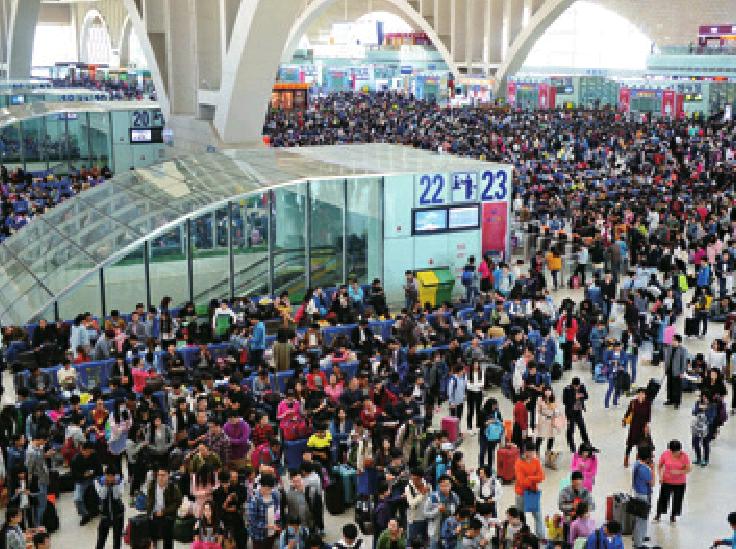Food Welcome
2015-11-02
A young girl tries food made by Pakistani students during an international culture festival at Hefei University of Technology in Hefei, Anhui Province, on October 7.
During the event, students from more than 10 countries and regions, including Laos, Angola and Pakistan, presented aspects of their respective cultures to Chinese attendees.
Nature Reserves
The ecological systems in Chinas nature reserves are stable with numbers of some endangered animals and plant species growing, the Ministry of Environmental Protection announced.
A ministry press release said that nature reserves at various levels are providing protection to more than 85 percent of rare species.
China has 428 nature reserves at national level, covering more than 96 million hectares. The population of endangered and rare species, such as golden monkeys, Asian elephants and dawn redwood trees, has been growing in these areas.
In more than 60 nature reserves for giant pandas, the number of wild giant pandas has increased from about 1,100 in 2000 to around 1,600.
Efforts to protect the crested ibis(Nipponia nippon) and its habitat have helped the population grow from only seven in 1981 to about 1,000 today.
Electric Charging
China has made major progress in unifying standards for electric vehicle charging ports, according to an announcement by the Ministry of Industry and Information Technology on October 2.
The ministry said that several national standards have been approved recently by experts, with higher charging power and enhanced security.
Zheng Shanjie, deputy head with the National Energy Administration, recently revealed that China will increase the number of charging stations and uniform standards for charging ports.
All electric car makers should comply with Chinas new standard when producing charging ports, he said, adding that U.S. company Tesla will manufacture its cars in accordance.
At a State Council meeting in late September, it was decided that new residential complexes should ensure all parking lots have charging facilities or space for such facilities, while a minimum of 10 percent of parking lots in large public buildings or public car lots should have charging facilities.
Chinas new energy vehicle sector has seen explosive growth in the past two years, thanks to subsidies and tax cuts. In the first eight months of this year, sales of new energy vehicles rose by 270 percent.
Traditional Villages
Initiators of a conservation program said on October 7 that they had surveyed and made records of 218 traditional Chinese villages since June.
Pu Jiao, Deputy Director of the Research Center for Conservation and Development of Chinese Traditional Villages, said that the 218 villages are among 2,555 state-recognized traditional villages. Being recognized by the state merits official protection.
Among the 218 villages, the largest group is located in north Chinas Hebei Province. A first volume of the Records of Traditional Chinese Villages, which will cover the Hebei villages, will be published by the end of this year.
The survey aims to research traditional Chinese villages by gathering information to be recorded both in text and photos. Eight categories of information will be collected based on anthropological and folkloric principles.
Traditional villages are those where the original village layout, typical houses and classic architecture are still largely intact. There are over 5,000 traditional villages worthy of conservation in China.
Heart Risk
Heart disease is increasingly affecting younger generations in China, while medical experts predict a surge in cases over the next decade.
The findings, published by the National Center for Cardiovascular Diseases, said that one in five Chinese is in “poor cardiovascular shape,” and one person dies from heart disease every 10 seconds in China.
Statistics show that the number of Chinese aged 35 to 44 with coronary heart disease has increased 30 percent over the last three years, and the death rate of the same age group has risen 111 percent over the past 15 years.
“Cardiovascular disease is currently one of the leading causes of death in China,” said Shi Xubo, cardiologist with Beijing Tongren Hospital. “China should adopt an intervention strategy to improve the health of its citizens.”
Aircraft Tracking
China has successfully launched three cube satellites (CubeSats), which are expected to help track civil aircraft and ships and avoid tragedies like missing flight Malaysia Airlines Flight 370.
The three CubeSats in a mission coded STU-2 were launched on September 25 and have entered their designed orbits, according to the missions chief designer Wu Shufan.
The three spacecraft are equipped with polar region observation cameras as well as automatic identification system receivers for information from ships and automatic dependent surveillancebroadcast (ADS-B) receivers for messages sent from civil flights.
The ADS-B system was developed to be installed on civil aircraft and transmit readings of the flights position, height, speed, direction and other information automatically every second to receivers on the ground or in the air. Currently more than 70 percent of aircraft have such systems installed.
As of the evening of September 28, the STU-2 CubeSats had collected hun- dreds of thousands of ADS-B messages from more than 12,400 aircraft flying within receiving range.
The paths and traffic flow of civil flights within the satellites monitoring area may be collected in real time.
Wu said that the STU-2 mission, the first of its kind by China, is a step in the countrys satellite network development for civil aircraft and ship monitoring.
Painting From Palace
A large imperial portrait of consort Chunhui by Giuseppe Castiglione is auctioned out for HK$137.4 million ($18 million) at Sothebys in Hong Kong on October 7.
Castiglione is an Italian Jesuit missionary who arrived in China in 1715 and stayed for 51 years, serving as an accomplished painter under three emperors of the Qing Dynasty (1644-1911)—Kangxi, Yongzheng and Qianlong.
Typhoon Damage
A car is submerged in a flooded street in Guangzhou, south Chinas Guangdong Province, after Typhoon Mujigae brought heavy rain to the city on October 5.
As of October 6, Typhoon Mujigae had claimed at least 19 lives and left four people missing since it made landfall in Guangdong. About 3.5 million people were affected, of whom 170,400 were relocated from their damaged homes.
Juilliard in China
New Yorks renowned Juilliard School will launch its first overseas campus to offer graduate courses in music in the northern Chinese municipality of Tianjin by 2018, reported the China Radio International.
Sources with the administrative commission of Tianjin Binhai New District said on October 2 that the Juilliard Schools Tianjin branch will be established in Yujiapu Financial District.
The masters degree to be awarded by the Juilliard schools Tianjin branch will be accredited in the United States. The partnership will be the first such collaboration between Chinese and foreign conservatories.
The Juilliard School was founded in 1905, and its alumni have collectively won more than 105 Grammy Awards, 62 Tony Awards and 47 Emmy Awards.
China Welcomes TPP
Chinas Ministry of Commerce on October 6 said China welcomes the Trans-Pacific Partnership (TPP) free trade agreement and hopes it can facilitate other regional free trade talks to push forward economic growth in the Asia-Pacific region.
The ministrys spokesperson said this agreement is one of the most important free trade deals in the AsiaPacific region, and China takes an open attitude toward efforts and actions that promote regional economic integration and system development in the AsiaPacific region under the rules of the World Trade Organization.
The comments came after the trade ministers of the United States and 11 other countries in the Pacific Rim reached an agreement on the TPP in Atlanta on October 5, even though the final ratification of this ambitious deal in the member nations is far from certain.
After more than five years of negotiations, the agreement was signed by Australia, Brunei, Canada, Chile, Japan, Malaysia, Mexico, New Zealand, Peru, Singapore, the United States and Viet Nam, which together account for 40 percent of the world economy.
The content of the TPP talks mainly covered intellectual property protection, cross-border e-commerce, investment, the service trade, government procurement, labor treatment, the environment and tariff reductions.
Gao Hucheng, Chinas commerce minister, said earlier this year that the country will continue to study and assess the impact of the TPP and the proposed Transatlantic Trade and Investment Partnership between the United States and European Union and will pursue its own free trade strategies.
Travel Rush
Passengers wait to board trains in Shijiazhuang Railway Station, north Chinas Hebei Province, on October 7, the last day of the National Day holiday (October 1-7).
Yuan More Popular
The Chinese currency, the yuan, became the fourth most-used world payment currency in August, overtaking the Japanese yen, global transaction services organization SWIFT said on October 6.
The yuan has surpassed seven currencies in the past three years as a payment currency, falling behind only the U.S. dollar, the euro and the pound.
Overall, global yuan payments increased in value by 9.13 percent in August, while payments across all currencies decreased by 8.3 percent, according to the organization.
The yuan reached a record high market share of 2.79 percent in global payments for the month, compared to 1.39 percent in January 2014.
More than 100 countries used the yuan for payments in August, of which over 90 percent of flows were concentrated in 10 countries. Singapore processed 24.4 percent, followed by the UK with 21.6 percent.
More than 1,700 financial institutions made worldwide payments in the yuan, up 14 percent from a year earlier. In the trade finance sector, the yuan has a 9.1-percent share in the global issuance of letters of credit by value, strengthening its position as the second most used currency for this purpose.
To further promote the global use of the Chinese currency, the first phase of the Cross-border Interbank Payment System was launched in Shanghai on October 8, designed as an “expressway”to facilitate the yuans use in international trade and investment.
Lower Down Payment
China on September 30 said it will cut the minimum down payment level for first-time home buyers in many cities, stepping up support for the sluggish property market and slowing economy.
The Peoples Bank of China and the China Banking Regulatory Commission said they would be lowering minimum down payments for first-time home buyers to 25 percent, from the previous 30 percent, in cities that do not have restrictions on purchases.
The lower down payment requirements will not apply in certain big cities—such as Beijing, Shanghai and Shenzhen—that have imposed restrictions on buying to prevent bubbles.
“The relaxed rule is helpful, but the impact will not be immediate because the main reason for high inventory in some cities is bad location and transportation,” said David Ji, greater China head of research and consulting at Knight Frank.
“The new rule will likely stimulate demand from buyers who are already observing on the sidelines and help them to get into the market,” Ji added.
Time-Saving Connection
A bullet train arrives in Anqing Railway Station, east Chinas Anhui Province on September 30.
That day, the Nanjing-Anqing high-speed railway completed testing and is expected to begin operation by the years end.
The high-speed route will greatly shorten the travel time from Anqing to Nanjing, capital of east Chinas Jiangsu Province, and Shanghai.
Energetic Travel
Chinas new energy vehicles (NEVs) are shifting into high gear fueled by a string of favorable policies, with strong sales despite a lackluster automobile market.
On September 29, the State Council asked local authorities to lift purchase restrictions and remove traffic controls for NEVs while retaining curbs for cars running on fossil fuels, to stimulate sales and development of eco-friendly vehicles.
Buyers of electric cars will be able to obtain license plates without applying through the usual lottery systems in place in some major cities. In Beijing, 40 percent of applicants obtained permits to buy NEVs in August, while the acceptance rate for traditional car buyers was only 0.5 percent.
Manufacturing Activity
Chinas factory activity picked up slightly in September but remained in contraction as the countrys manufacturing sector saw improved—yet still weak—demand, official data showed on October 1.
Chinas manufacturing purchasing managers index (PMI) came in at 49.8 in September, up from 49.7 for August, according to data released by the National Bureau of Statistics (NBS) and the China Federation of Logistics and Purchasing (CFLP).
A reading above 50 indicates expansion, while that below 50 represents contraction.
The index fell into contraction territory for the fourth time this year, but the slight increase in September was a reversal from two months of decline in a row previously.
Anemic demand and downward pressure persisted in the manufacturing industry, but there was a recovery in production and market demand, said NBS statistician Zhao Qinghe.
On the other side of the equation, in September, Chinas non-manufacturing activity held steady as business growth in the service industry continued to accelerate, according to the NBS and the CFLP. The PMI for the nonmanufacturing sector stayed at 53.4 in September, unchanged from August.
A Powerful Combination
Two of Chinas largest online-to-offline service providers announced a merger on October 8, in a move to end their escalating battle to win customers and corner the market. Meituan.com, a group-buying site backed by Alibaba Group Holdings Ltd. and restaurant rating website Dianping.com, which is funded by Tencent Holdings Ltd., said in a joint statement that they have struck a strategic merger.
The new company will run on a co-CEO basis and keep the original structure of their respective human resources. Meituan and Dianping will continue to run their businesses in parallel, retain their brands, and remain independent.
“The two companies merging will allow absolute dominance of the groupbuying market and require less cash burn,” said Wang Weidong, an analyst at research firm iResearch in Beijing.
Meituan accounted for 51.9 percent of Chinese group buying transactions in the first six months of this year, according to Analysys International. Dianping accounted for 29.5 percent, followed by Baidus Nuomi with 13.6 percent.
